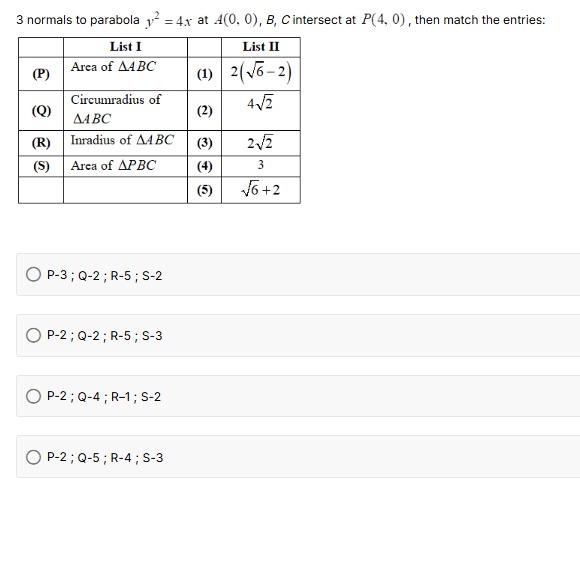Question
Question: 3 normals to parabola $y^2 = 4x$ at $A(0, 0)$, $B$, $C$ intersect at $P(4, 0)$, then match the entri...
3 normals to parabola y2=4x at A(0,0), B, C intersect at P(4,0), then match the entries:

Area of △ABC
Circumradius of △ABC
Inradius of △ABC
Area of △PBC
P -> 2, Q -> 4, R -> 1, S -> 2
Solution
We begin with the parabola
y2=4x,which is conveniently parametrized as
(x,y)=(t2,2t).For a point on the parabola corresponding to parameter t, the equation of the normal is derived as follows. The tangent at (t2,2t) has slope
dxdy=t1(t=0),so the normal (perpendicular) has slope −t. Its equation (through (t2,2t)) is
y−2t=−t(x−t2)⟹y=−tx+t3+2t.We are told that three normals drawn at the points A, B, and C of the parabola meet at a common point P=(4,0). One of these is given as A=(0,0) (for which t=0). For the normal to pass through P(4,0) we substitute into the normal’s equation:
0=−t(4)+t3+2t=t3−4t+2t=t3−2t.Thus,
t(t2−2)=0.The three solutions are:
t=0,t=2,t=−2.This gives the points:
A=(02,2⋅0)=(0,0), B=((2)2,22)=(2,22), C=((−2)2,2(−2))=(2,−22).Now we determine the required quantities.
(P) Area of △ABC:
Use the determinant formula:
ΔABC=21det(xB−xAxC−xAyB−yAyC−yA)=21(2)(−22)−(2)(22).Compute:
(2)(−22)−(2)(22)=−42−42=−82.Taking absolute value and halving:
ΔABC=21⋅82=42.Thus, (P) matches the entry 42.
(Q) Circumradius of △ABC:
First, find the lengths of the sides:
AB=(2−0)2+(22−0)2=4+8=23, AC=(2−0)2+(−22−0)2=23, BC=(2−2)2+(22−(−22))2=(42)2=42.The circumradius R for any triangle is given by
R=4Δabc.Substitute:
R=4⋅(42)(23)(23)(42)=162(4⋅3)(42)=162482=3.So, (Q) is 3.
(R) Inradius of △ABC:
The inradius is
r=sΔ,where the semiperimeter s is
s=2AB+AC+BC=223+23+42=23+22.Thus,
r=2(3+2)42=3+222.Multiply numerator and denominator by 3−2:
r=3−222(3−2)=22(3−2)=26−4.This is written as 2(6−2).
(S) Area of △PBC:
The vertices are P=(4,0), B=(2,22), and C=(2,−22). Notice that B and C lie vertically above and below (2,0). Thus, the base BC is vertical with length:
BC=∣22−(−22)∣=42.The horizontal distance from P (with x=4) to the line x=2 is 2. Hence,
ΔPBC=21×(42)×2=42.So, (S) again is 42.
Final Matching:
- (P) Area of △ABC → 42
- (Q) Circumradius of △ABC → 3
- (R) Inradius of △ABC → 2(6−2)
- (S) Area of △PBC → 42
